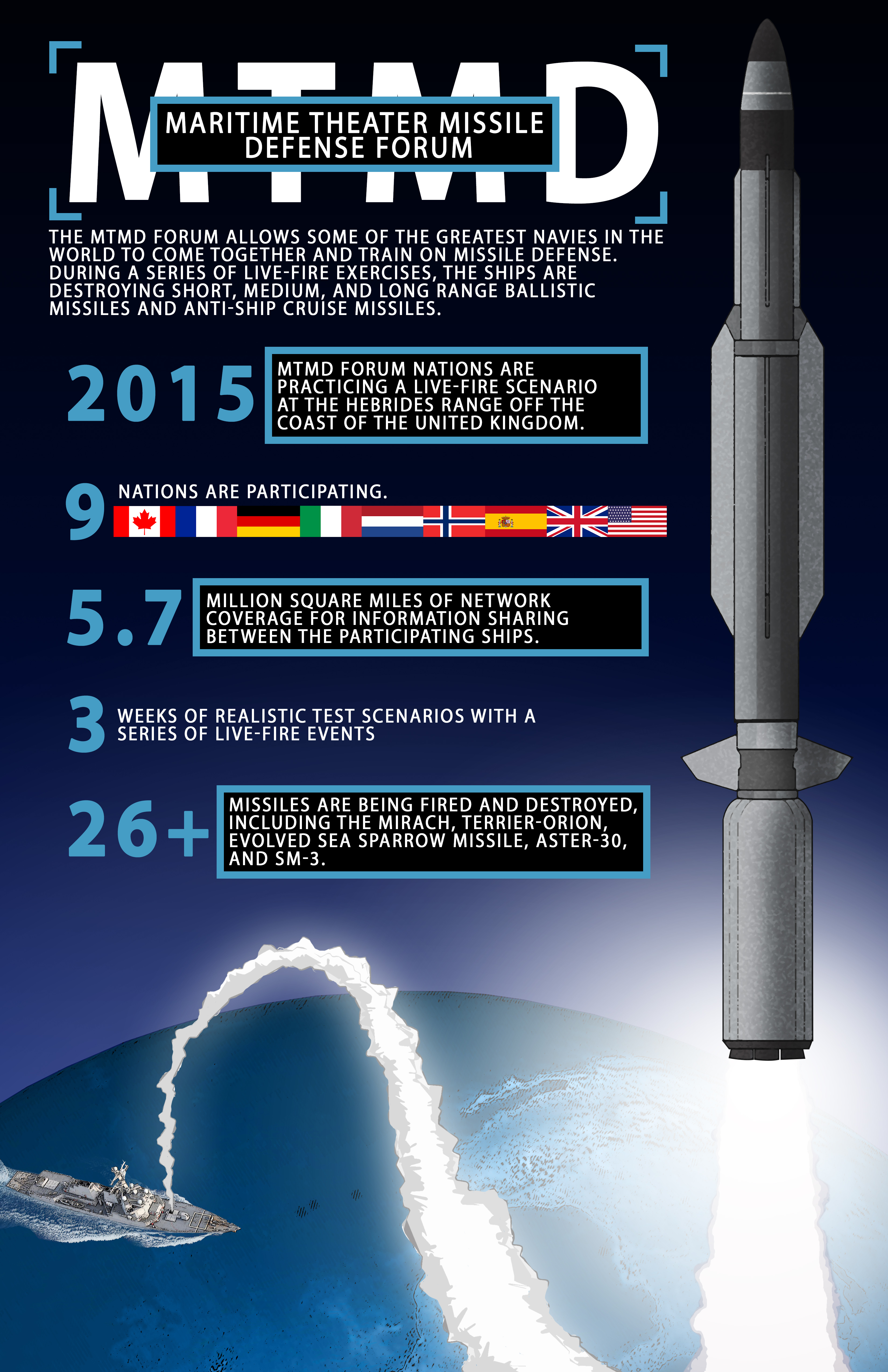
This post has been updated to include additional information from the U.S. Navy and Lockheed Martin.
The U.S. Navy and eight other countries are successfully working through an international detect-to-engage integrated air and missile defense exercise off the coast of Scotland, proving their platforms and people could integrate to provide missile defense in Europe.
The Maritime Theater Missile Defense (MTMD) Forum, consisting of 10 countries, is hosting a three-week Integrated Air and Missile Defense (IAMD) At Sea Demonstration.
“Today, nine member nations of the Maritime Theater Missile Defense Forum, under the auspices of the U.S. Missile Defense Agency, successfully conducted the simultaneous engagement of a ballistic missile in space and an anti-ship cruise missile target, the first demonstration of this capability in the European theater,” Commander of U.S. Naval Forces Europe-Africa Adm. Mark Ferguson said in an Oct. 20 statement.
“The execution of the live-fire exercise is a clear demonstration of the forum’s ability to safely conduct effective coalition sea-based defense against simultaneous anti-ship and ballistic missile threats within an operational scenario.”
One of the Navy’s four forward-deployed guided-missile destroyers – home-ported at Naval Station Rota, Spain, with a special focus on theater ballistic missile defense missions – participated in the exercise, along with planes and ships from Canada, France, Italy, The Netherlands, Norway, Spain, and the United Kingdom and personnel from Germany. Australia is a forum member but did not participate in this event.
“I am particularly proud of the performance of the USS Ross (DDG-71), based in Rota, Spain,” Ferguson said in the statement.
“Ross conducted, in a flawless fashion, the exo-atmospheric ballistic missile intercept in the European theater, based on data provided by an allied ship. This exercise demonstrates the commitment of the United States to the defense of Europe through our Aegis ships and our shore station in Romania, as well as the professional performance of our allied Sailors.”
In the most notable portion of the demonstration, conducted Tuesday, a short-range Terrier Orion ballistic missile target was launched from Hebrides Range and was inflight simultaneously with two anti-ship cruise missiles fired at the coalition task group, according to a Navy statement. Ross fired a Raytheon Standard Missile-3 and successfully engaged the ballistic missile target in space. In its air defense role, USS The Sullivans (DDG-68) fired a SM-2.
The demonstration was the first time an SM-3 Block IA guided interceptor was fired on a non-U.S. range, the first intercept of a ballistic missile threat in the European theater, and the first time an SM-2 was fired on the Hebrides Range.
During the demonstration, the nine countries have had to defend against simultaneous anti-ship and ballistic missile threats originating from multiple locations. The countries had to pass information over a total of 5.7 million square miles, using a variety of platforms from different countries to identify, track and ultimately engage the threats. The coalition fired more than 26 missiles, including the Evolved Sea Sparrow Missile and the SM-3 in the U.S. inventory and the Aster-30 surface-to-air missile used by France, Italy and the U.K.
“To remain proficient, we must practice unified, decisive, and timely command and control,” Vice Adm. James Foggo, commander of U.S. 6th Fleet, said in a statement ahead of the demonstration.
“Continuous training also hones our operational tactics, techniques, and procedures, which helps us achieve the level of readiness required to execute such a demanding fast-paced mission as BMD.”

The United Kingdom is hosting the event at its Hebrides Missile Test Range. Commodore Frank Sijtsma of the Royal Netherlands Navy commands the task group, and U.S. Navy Rear Adm. John Hill, Program Executive Officer for Integrated Warfare Systems, chairs the MTMD Forum. The event will continue through the rest of the month, with additional ballistic missile detection exercises and anti-air warfare events planned, according to Mary Keifer, Lockheed Martin’s Aegis in-service and fleet readiness program director.
In addition to forward-stationing the four destroyers in Spain and participating in international exercises, the United States is also boosting its theater missile defense capabilities through two land-based missile defense Aegis Ashore sites, part of the European Phased Adaptive Approach to missile defense.
Russia has been vocal about its concerns regarding the U.S. build-up of missile defense assets, which the United States has said are meant to protect against Iranian missiles but Russia sees as a threat to its own military capabilities.
Earlier this year, when Norway announced it would participate in the at-sea demonstration, Russian Deputy Defense Minister Anatoly Antonov said, “we believe that the exercises involving the U.K., Italy, Canada, the Netherlands and France, in addition to Norway and the United States, will be tasked to bolster practice of joint air and missile defense and to test U.S. SM-3 interceptor missiles. The exercises will be held in northeastern parts of the Atlantic, which may be proof of just one thing: they are planning to practice interception of Russian ballistic missiles.”





